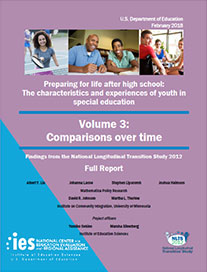The third report volume from the National Longitudinal Transition Study 2012 (NLTS 2012) presents information on the changes over time in the characteristics and high school experiences of secondary students participating in special education. NLTS 2012 is part of the congressionally-mandated National Assessment of the Individuals with Disabilities Education Act 2004 (IDEA 2004) and is the third longitudinal study conducted by the U.S. Department of Education over several decades focused on youth with an individualized education program (IEP) supported by IDEA. This third volume compares survey data in 1987, 2003, and 2012 from the three NLTS, focusing on 15- to 18-year olds with an IEP overall and in 12 federal disability groups. Where comparable data are available, the volume also examines trends for 19- to 21-year olds who are still enrolled in high school.
Findings from the third volume suggest that, over the past decade (2003–2012), youth with an IEP have become more engaged in school and increased their use of school supports. At the same time, youth with an IEP are less likely than in the past to take some key steps to prepare for their transition to adult life. Among students with an IEP, youth with emotional disturbance and youth with intellectual disability experienced more positive changes over the past decade than youth in other disability groups.
Project: National Longitudinal Transition Study (NLTS), Phase 2
Download:
- Volume 3 – Full Report (PDF)
Citation
Liu, A. Y., Lacoe, J., Lipscomb, S., Haimson, J., Johnson, D. R., & Thurlow, M. L. (2018). Preparing for life after high school: The characteristics and experiences of youth in special education. Findings from the National Longitudinal Transition Study 2012. Volume 3: Comparisons over time (Full report) (NCEE 2018-4007). Washington, DC: U.S. Department of Education, Institute of Education Sciences, National Center for Education Evaluation and Regional Assistance
Populations: Students with disabilities
Services: Research and evaluation

